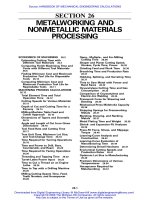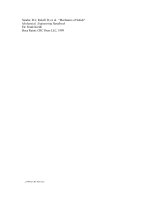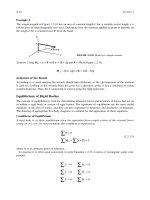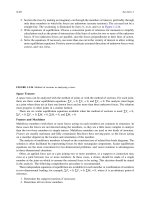CRC Press - Mechanical Engineering Handbook- Mechanics Of Solids Part 11 pot
Bạn đang xem bản rút gọn của tài liệu. Xem và tải ngay bản đầy đủ của tài liệu tại đây (38.34 KB, 1 trang )
1-100 Section 1
The plane polariscope (Figure 1.5.42) consists of a light source, two polarizing elements, and the
model. The axes of the two polarizing elements are oriented at a 90° angle from each other. If the
specimen is not stressed, no light passes through the analyzer and a dark field is observed. If the model
is stressed, two sets of fringes, isoclinics and isochromatics, will be obtained. Black isoclinic fringe
patterns are the loci of points where the principal-stress directions coincide with the axis of the polarizer.
These fringe patterns are used to determine the principal stress directions at all points of a photoelastic
model. When the principal stress difference is zero (n = 0) or sufficient to produce an integral number
of wavelengths of retardation (n = 1, 2, 3, ), the intensity of light emerging from the analyzer is zero.
This condition for extinction gives a second fringe pattern, called isochromatics, where the fringes are
the loci of points exhibiting the same order of extinction (n = 0, 1, 2, 3, …).
(1.5.65)
where N is the isochromatic fringe order. The order of extinction n depends on the principal stress
difference (σ
1
– σ
2
), the thickness h of the model, and the material fringe value f
σ
. When monochromatic
light is used, the isochromatic fringes appear as dark bands. When white light is used, the isochromatic
fringes appear as a series of colored bands. Black fringes appear in this case only where the principal
stress difference is zero.
A circular polariscope is a plane polariscope with two additional polarizing plates, called quarter-
wave plates, added between the model and the original polarizing plates (Figure 1.5.43). The two quarter-
wave plates are made of a permanently doubly refracting material. The circular polariscope is used to
eliminate the isoclinic fringes while maintaining the isochromatic fringes. To accomplish this, mono-
chromatic light must be used since the quarter-wave plates are designed for a specific wavelength of
light. For the dark-field arrangement shown, no light is passed through the polariscope when the model
is unstressed. A light-field arrangement is achieved by rotating the analyzer 90°. The advantage of using
FIGURE 1.5.42Schematic of a stressed photoelastic model in a plane polariscope.
nN
h
f
== −
()
σ
σσ
12









